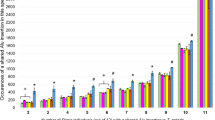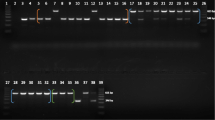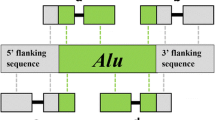Abstract
Allelic frequency data derived from five polymorphic Alu insertion loci and five point mutation polymorphic loci were compared to determine their ability to infer phylogenetic relationships among human populations. While point mutation polymorphisms inferred a monophyletic Caucasian clade that is corroborated by other studies, these data failed to support the generally accepted monophyly of Orientals with native Americans. In addition, there is less statistical bootstrap support for the maximum-likelihood tree derived from the point mutation polymorphisms as compared to those generated from either the Alu insertion data or the combined Alu insertion+point mutation data. The Alu data and the combined Alu insertion+point mutation data inferred a monophyletic relationship among the Oriental and native American populations. The Alu insertion data and the combined Alu insertion+point mutation data also displayed two separate, well defined, tight clusters of the Caucasian and the Oriental+native American populations which was not inferred from the point mutation data. These findings indicate greater phylogenetic information contained in Alu insertion frequencies than in allelic frequencies derived from point-mutations.
Similar content being viewed by others
References
Armour, J.A.L. & A.J. Jeffreys, 1992. Biology and applications of human minisatellite loci. Curr. Opin. Genet. Dev. 2: 850–856.
Batzer, M.A., V.A. Gudi, J.C. Mena, D.W. Foltz, R.J. Herrera & P.L. Deininger, 1991. Amplification dynamics of human-specific (HS) Alu family members. Nucleic Acids Res. 19: 3619–3623.
Batzer, M.A. & P.L. Deininger, 1991. A human-specific subfamily of Alu sequences. Genomics 9: 481–487.
Batzer, M.A., M. Stoneking, M. Alegria-Hartrnan, H. Bazan, D.H. Kass, T.H. Shaikh, G.E. Novick, P.A. Loannou, W.D. Scheer, R.J. Herrera & P.L. Deininger, 1994. African origin of human specific polymorphic Alu insertions. Proc. Natl. Acad. Sci. USA 91: 12288–12292.
Batzer, M.A., S.S. Arcot, J.W. Phinney, M. Alegria-Hartman, D.H. Kass, S.M. Milligan, C. Kimpton, P. Gill, M. Hochmeister, P.A. Ioannou, R.J. Herrera, D.A. Boudrea, W.D. Scheer, B.J. Keats, P.L. Deininger & M. Stoneking, 1995. Dispersion and insertion polymorphism in two small subfamilies of recently amplified Alu repeats. J. Mol. Evol. 247: 418–427.
Brown, R.J., D.J. Rowold, M.A. Tahir, C. Barna, G. Duncan & R.J. Herrera, 2000. Distribution of the HLA-DQA1 and polymarker alleles in the basque population of Spain. Forensic Sci. Int. in Press.
Cavalli-Sforza, L.L. & A.W.F. Edwards, 1967. Phylogenetic analysis: Models and estimation procedures. Evolution. 32: 550–570.
Cavalli-Sforza, L., P. Menozzi & A. Piazza, 1994. The history and geography of human genes. Princeton University Press, Princeton.
Daniels, G.R. & P.L. Deininger, 1985. Integration site preferences of the Alu family and similar repetitive DNA sequences. Nucleic Acids Res. 13: 8939–8954.
Farris, J.S., 1981. Distance data in phylogenetic analysis. pp. 3–22 in Advances in Cladistics, edited by V.A. Funk and D.R. Brooks. The New York Botanical Garden, Bronx.
Felsenstein, J., 1981. Evolutionary trees from gene frequencies and quantitative characters: finding maximum likelihood estimates. Evolution. 35: 1229–1242.
Felsenstein, J., 1985. Phylogenies from gene frequencies: A statistical problem. Syst. Zool. 34: 300–311.
Felsenstein, J., 1995. PHYLIP (Phylogeny Inference Package) version 3.573c. Distributed by the author. Department of Genetics, University of Washington, Seattle.
Fitch, W.M. & E. Margoliash, 1967. Construction of phylogenetic trees. Science 155: 279–284.
Greenberg, J.H., C.G. II Turner & S.L. Zegura, 1986. The settlement of the Americas: A comparison of the linguistic, dental, and genetic evidence. Curr. Anthropol. 27(5): 477–497.
Hamdi, H., H. Nishio, R. Zielinski & A. Dugiczyk, 1989. Origin and phylogenetic distribution of Alu DNA repeats: Irreversible Events in the Evolution of Primates. J. Mol. Biol. 289: 861–871.
Hammer, M.F., A.B. Spurdle, T. Karafet, M.R. Bonner, E.T. Wood, A. Novelletto, P. Malaspina, R.J. Mitchell, J.S. Horai, T. Jenkins & S.L. Zegura., 1997. The geographic distribution of human Y chromosome variation. Genetics. 145: 787–805.
Hennig, W., 1966. Phylogenetic Systematics. Univ. of Illinois Press, Urbana.
J.M. Hayes, B. Budowle & M. Freund, 1995. Arab population data on the PCR-based loci: HLA-DQA1, LDLR, BYPA, HBGG, D1S80. J. Forensic Sci. 40(5): 888–892.
Jeffreys, A.J., N.J. Royle, V. Wilson & Z. Wong, 1988. Spontaneous mutation rates to new length alleles at tandem-repetitive hypervariable loci in human DNA. Nature 332: 278–281.
Maddison, W.P., 1997. Gene trees in species trees. Sys. Biol. 46: 523–536.
Mickevich, M.F. & C. Mitter, 1981. Treating polymorphic characters in systematics: A phylogenetic treatment of electrophoretic data, pp. 45–60 in Advances in Cladistics, edited by N.I. Platnick and V.A. Funk, Vol. 2. Columbia Univ. Press, New York.
Moritz, C. & D.M. Hillis, 1996. Molecular systematics: context and controversies, pp. 1–13 in Molecular Systematics, edited by D.M. Hillis, C. Moritz, and B.K. Mable. 2nd Edn., Sinauer Associates, Inc. Sunderland.
Nei, M, 1987. Molecular evolutionary genetics. Columbia University Press, New York.
Nei, M. & A.K. Roychoudhury, 1993. Evolutionary relationships of human populations on a global scale. Mol. Biol. Evol. 10: 927–943.
Novick, G.E., M.A. Batzer, P.L. Deininger & R.J. Herrera, 1996. The mobile genetic element Alu in the human genome. Bioscience 46: 32–41.
Novick, G.E., C.C. Novick, J. Yunis, E. Yunis, P. Antunez de Mayolo, W.D. Scheer, P.L. Deininger, M. Stoneking, D.S. York, M.A. Batzer & R.J. Herrera, 1998. Polymorphic Alu insertions and the Asian origin of native American populations. Hum. Biol. 70(1): 23–39.
Perez-Lezaun, A., F. Calafell, E. Mateau, D. Comas, I. Bosch & J. Bertranpetit, 1997. Allele frequency of 20 microsatellites in a worldwide population survey. Hum. Hererd. 47: 189–196.
Rogers, J.S., 1986. Deriving phylogenetic trees from allele frequencies: A comparison of nine genetic distances. Syst. Zool. 35: 297–310.
Saiton, N. & M. Nei, 1987. The neighbor-joining method: A new method for reconstructing phylogenetic trees. Mol. Biol. Evol. 4: 406–425.
Schlötter, C. & D. Tautz, 1992. Slippage synthesis of simple sequence DNA. Nucleic Acids Res. 20: 211–215.
Shriver, M.D., J. Li, R. Chakraborty & E. Boerwinkle, 1993. VNTR allele frequency distributions under the stepwise mutation model: A computer simulation approach. Genetics. 134: 983–993.
Sneath, P.H.A. & R.R. Sokal, 1973. Numerical taxonomy: The principles and practice of numerical classification. W.H. Freeman. San Francisco.
Swofford, D.L. & S.H. Berlocher, 1987. Inferring evolutionary trees from gene frequency data under the principle of maximum parsimony. Syst. Zool. 36: 293–325.
Swofford. D.L., G.J. Olsen, P.J. Waddell & D.M. Hillis, 1996. Phylogenetic Inference, pp. 407–514 in Molecular Systematics, edited by D.M. Hillis, C. Moritz, and B.K. Mable. 2nd Edn., Sinauer Associates, Inc. Sunderland.
Swofford, D.L., 1998. PAUP*. Phylogenetic analysis using parsimony (* and Other Methods). Vers. 4.0. Sinauer Associates, Inc., Sunderland.
Szmulewicz, M.N., G.E. Novick & R.J. Herrera, 1998. Effects of Alu insertions on gene function. Electrophoresis 19: 1260–1264.
Tautz, D., 1989. Hypervariability of simple sequences as a general source for polymorphic DNA markers. Nucleic Acids Res. 17: 6463–6471.
Thomas, E. & R.J. Herrera, 1998. Multiplex polymerase chain reaction of Alu polymorphic insertions. Electrophoresis 19: 2373–2379.
Ullu, E. & A.M. Weiner, 1985. Upstream sequences modulate the internal promoter of the human 7SL RNA gene. Nature 318: 371–374.
Walkinshaw, M., L. Strickland, H. Hamilton, K. Denning & T. Gayley, 1996. DNA profiling in two Alaskan native populations using HLA-DQA1, PM and D1S80 loci. J. Forensic Sci. 41(3): 478–484.
Weber, J.L. & P.E. May, 1989. Abundant class of human DNA polymorphism which can be typed using the polymerase chain reaction. Am. J. Hum. Genet. 44: 388–396.
Williams, J.G.K., A.R. Kubelik, K.J. Livak, J.A. Rafalski & S.V. Tingey, 1990. DNA polymorphisms amplified by arbitrary primers are useful as genetic markers. Nucleic Acids Res. 18: 6531–6535.
Author information
Authors and Affiliations
Rights and permissions
About this article
Cite this article
York, D.S., Blum, V.M., Low, J.A. et al. Phylogenetic signals from point mutations and polymorphic Alu. Genetica 107, 163–170 (1999). https://doi.org/10.1023/A:1004078805609
Issue Date:
DOI: https://doi.org/10.1023/A:1004078805609




